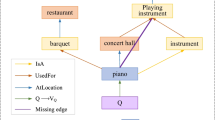Abstract
Knowledge of noun phrase anaphoricity might be profitably exploited in coreference resolution to bypass the resolution of non-anaphoric noun phrases. However, it is surprising to notice that recent attempts to incorporate automatically acquired anaphoricity information into coreference resolution systems have been far from expectation. This paper proposes a global learning method in determining the anaphoricity of noun phrases via a label propagation algorithm to improve learning-based coreference resolution. In order to eliminate the huge computational burden in the label propagation algorithm, we employ the weighted support vectors as the critical instances to represent all the anaphoricity-labeled NP instances in the training texts. In addition, two kinds of kernels, i.e., the feature-based RBF (Radial Basis Function) kernel and the convolution tree kernel with approximate matching, are explored to compute the anaphoricity similarity between two noun phrases. Experiments on the ACE2003 corpus demonstrate the great effectiveness of our method in anaphoricity determination of noun phrases and its application in learning-based coreference resolution.
Similar content being viewed by others
References
Soon W M, Ng H T, Lim D. A machine learning approach to coreference resolution of noun phrase. Computational Linguistics, 2001, 27(4): 521-544.
Ng V, Cardie C. Improving machine learning approaches to coreference resolution. In Proc. ACL 2002, Philadelphia, USA, Jul. 6-12, 2002, pp.104-111.
Strube M, Muller C. A machine learning approach to pronoun resolution in spoken dialogue. In Proc. ACL 2003, Sapporo, Japan, Jul. 7-12, 2003, pp.68-175.
Yang X F, Zhou G D, Su J, Chew C L. Coreference resolution using competition learning approach. In Proc. ACL 2003, Sapporo, Japan, Jul. 7-12, 2003, pp.177-184.
Yang X F, Su J, Lang J, Tan C L, Liu T, Li S. An entity-mention model for coreference resolution with inductive logic programming. In Proc. ACL 2008, Columbus, USA, Jun. 15-20, 2008, pp.843-851.
Paice C D, Husk G D. Towards the automatic recognition of anaphoric features in English text: The impersonal pronoun it. Computer Speech and Language, 1987, 2(2): 109-132.
Lappin S, Leass H J. An algorithm for pronominal anaphora resolution. Computational Linguistics, 1994, 20(4): 535-561.
Kennedy C, Boguraev B. Anaphora for everyone: Pronominal anaphora resolution without a parser. In Proc. COLING 1996, Copenhagen, Denmark, Aug. 5-9, 1996, pp.113-118.
Denber M. Automatic resolution of anaphora in English. Technical Report, Eastman Kodak Co. 1998.
Vieira R, Poesio M. An empirically based system for processing definite descriptions. Computational Linguistics, 2000, 27(4): 539-592.
Bean D, Riloff E. Corpus-based identification of non-anaphoric noun phrases. In Proc. ACL 1999, University of Maryland, College Park, USA, Jun. 20-26, 1999, pp.373-380.
Bergsma S, Lin D K, Goebel R. Distributional identification of non-referential pronouns. In Proc. ACL 2008, Columbus, USA, Jun. 15-20, 2008, pp.10-18.
Evans R. Applying machine learning toward an automatic classification of it. Literary and Linguistic Computing, 2001, 16(1): 45-57.
Ng V, Cardie C. Identifying anaphoric and non-anaphoric noun phrases to improve coreference resolution. In Proc. COLING 2002, Taipei, China, Aug. 24-Sept. 1, 2002, pp.730-736.
Ng V. Learning noun phrase anaphoricity to improve conference resolution: Issues in representation and optimization. In Proc. ACL 2004, Barcelona, Spain, Jul. 21-26, 2004, pp.151-158.
Yang X F, Su J, Tan C L. A twin-candidate model of coreference resolution with non-anaphor identification capability. In Proc. IJCNLP 2005, Jeju Island, Korea, Oct. 11-13, 2005, pp.719-730.
Denis P, Baldridge J. Joint determination of anaphoricity and coreference using integer programming. In Proc. NAACLHLT2007, Rochester, USA, Apr. 22-27, 2007, pp.236-243.
Cherry C, Bergsma S. An expectation maximization approach to pronoun resolution. In Proc. CoNLL 2005, Ann Arbor, USA, Jun. 29-30, 2005, pp.88-95.
Zhu X, Ghahramani Z. Learning from labeled and unlabeled data with label propagation. CMU CALD Technical Report, CMU-CALD-02-107, 2002.
Charniak E. Immediate-head parsing for language models. In Proc. ACL 2001, Toulouse, France, Jul. 9-11, 2001, pp.129-137.
Yang X F, Su J, Tan C L. Kernel-based pronoun resolution with structured syntactic knowledge. In Proc. COLINGACL 2006, Sydney, Australia, Jul. 17-21, 2006, pp.41-48.
Zhou G D, Kong F, Zhu Q M. Context-sensitive convolution tree kernel for pronoun resolution. In Proc. IJCNLP 2008, Hyderabad, India, Jan. 7-12, 2008, pp.25-31.
Yang X F, Su J, Tan C L. A twin-candidate model for learning-based anaphora resolution. Computational Linguistics, 2008, 34(3): 327-356.
Haussler D. Convolution kernels on discrete structures. Technical Report UCS-CRL-99-10, University of California, Santa Cruz, USA, 1999.
Collins M, Duffy N. Convolution kernels for natural language. In Proc. NIPS 2001, Vancouver, Canada, Dec. 3-8, 2001, pp.625-632.
Zhang M, Che W X, Aw A T, Tan C L, Zhou G D, Liu T, Li S. A grammar-driven convolution tree kernel for semantic role classification. In Proc. ACL 2007, Prague, Czech Republic, Jun. 23-30, 2007, pp.200-207.
Moschitti A. Efficient convolution kernels for dependency and constituent syntactic trees. In Proc. ECML2006, Berlin, Germany, Sept. 18-22, 2006, pp.318-329.
Zhou G D, Su J. Error-driven HMM-based chunk tagger with context-dependent lexicon. In Proc. EMNLP-VLC 2000, Hong Kong, China, Oct. 7-8, 2000, pp.71-79.
Zhou G D, Su J. Named entity recognition using an HMM-based chunk tagger. In Proc. ACL 2002, Philadelphia, USA, Jul. 6-12, 2002, pp.473-480.
Joachims T. Text categorization with support vector machine: Learning with many relevant features. In Proc. ECML1998, Chemnitz, Germany, Apr. 21-23, 1998, pp.137-142.
Vilain M, Burger J, Aberdeen J, Connolly D, Hirschman L. A model theoretic coreference scoring scheme. In Proc. MUC-6, Columbia, USA, Nov. 1-3, 1995, pp.45-52.
Author information
Authors and Affiliations
Corresponding author
Additional information
Supported by the National Natural Science Foundation of China under Grant Nos. 60873150, 90920004 and 61003153.
Electronic supplementary material
Below is the link to the electronic supplementary material.
Rights and permissions
About this article
Cite this article
Zhou, GD., Kong, F. Learning Noun Phrase Anaphoricity in Coreference Resolution via Label Propagation. J. Comput. Sci. Technol. 26, 34–44 (2011). https://doi.org/10.1007/s11390-011-9413-x
Received:
Revised:
Published:
Issue Date:
DOI: https://doi.org/10.1007/s11390-011-9413-x




